Data Feminism Session 3 - Beyond the Gaps: Data-Feminist Approaches
January 25, 2023
Tal Barak, Lea Voigt
The Data Feminism Series, developed by the GIZ Data Lab with the Data Pop Alliance, aims to inspire and provide you with key applicable insights on Data Feminism by featuring diverse renowned experts from various sectors and working at multiple levels. This session was co-hosted by the GIZ competence centre working on Gender at our sectoral department, who have been working on gender data for many years.
In the third out of four events of the Data Feminism Series, taking place on January 17, we could learn from three outstanding thought leaders which have shaped the discussion on gender data: the Data-Pop Alliance (DPA), Data2X and the Aapti Institute. Each of them focusing on a different aspect of gender data, they shared their insights on their efforts to close data gaps and harness gender data to for evidence-based policymaking and impact – moving from gaps to data as a tool for solutions, advocacy, and empowerment.
1. Gender Data Capacity Development: A data feminist framework - Speaker: Anna Spinardi, Gender Expert and Program Lead in the Data Feminist Program (Data-Pop Alliance)
The Data-Pop Alliance (DPA) is a non-profit “think-and-do-tank” of researchers, experts, practitioners, policymakers, and activists created in 2013 out of MIT, Harvard and ODI. The DPA aims to “Change the World with Data” through projects in and with Global South countries.
Why is it important to develop gender data capacity?
Leveraging gender data to produce evidence for research, advocacy and policy purposes contributes to accelerate intersectional, feminist and LGBTQI+ inclusive gender equality, which is the core of SDG 5 in the UN 2030 Agenda for sustainable development and one of the core goals of the data feminist program in the DPA. Gender data capacity building can be fostered by developing skills across sectors that help to democratize the collection and use of gender data using a data literacy feminist framework.
What is data literacy?
Data literacy refers to the ability to read, analyse, write and communicate data for social good. When it comes to gender data literacy, one of the main challenges is avoiding bias. Therefore, we must advocate for a data feminist framework because data science is a form of power that can harm already marginalized and vulnerable groups. Embedding a data feminist framework in the process of data literacy is a form of challenging this power. The DPA follows the 7 data feminist framework principles by Catherine D’Ignazio and Lauren F. Klein in their book Data Feminism.
How can these principles be integrated into the data processing cycle?
The cycle can be divided into the following five stages: Collection, Cleaning, Processing Analysis and Output. The data feminist framework principles are transversal and should be applied collectively at each stage of the process. The graphic below describes each of the stages and exemplifies how the principles can be applied in each stage:
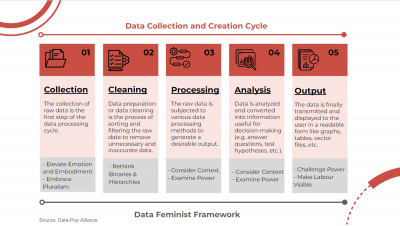
The four building blocks towards becoming gender data literate as defined by DPA:
The four building blocks shown below form the basis of DPA’s data-driven projects, and professional training workshops. The data feminist framework principles can and should be integrated in each of these dimensions for achieving gender data literacy.
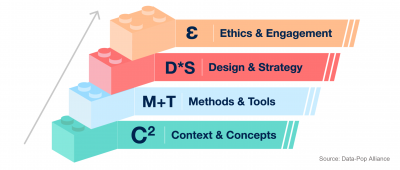
How does DPA promote gender data literacy in each dimension?
1. Context & Concepts:
This is the foundational dimension towards becoming gender data literate. The goal of this dimension is to (1) decode key terms and buzzwords in the gender data landscape, (2) discuss gender data within the political context of the post-2015 SDGs framework and data for social good, and (3) translate gender issues into specific data-driven objectives and actionable plans.
Decoding gender related terms requires the understanding of gender-related fundamental concepts (e.g., gender, gender identity, gender equality, sex, and sexual orientation). These terms and concepts are explained in the DPA Gender 201 Course, which is a free online course by DPA with support from Meta and hosted by the TechChange platform.
2. Methods & Tools:
The key goals of the second dimension towards gender data literacy are to (1) understand existing methods and tools used to leverage gender data, (2) assess data representativeness, biases and insights within data-driven approaches and methods, and (3) identify applicable tools by assessing the value added of gender data for specific development challenges.
DPA uses a mixed-methods methodology in their gender data projects while applying the feminist principles defined by Catherine D’Ignazio and Lauren F. Klein. Such methodology could integrate both quantitative and qualitative research methods, as well as traditional and non-traditional data sources collected or accessed at different stages of the project, with a participatory approach involving stakeholders that provided feedback and input throughout the entire project. The following projects were highlighted by DPA:
3. Design & Strategy:
The third dimension aims to (1) identify individual and organisational objectives towards a gender data strategy, (2) understand how to operationalize gender data in projects, partnerships, and policies, and (3) recognize individual and organizational next steps towards the best use and application of gender data.
An illustrative example towards achieving gender data literacy is a DPA project in collaboration with GIZ’s “FAIR Forward - Artificial Intelligence for All” initiative, financed by the BMZ. The DPA carried out an assessment that examined how the initiative and its partners have embedded the gender perspectives into their projects, into the AI training datasets created by the partner organizations and into the design, scope and outputs of the project. The DPA analysed:
- Integration of gender perspectives and indicators into the design and M&E of projects
- Potential gender bias in the AI training datasets created by partner organizations
- Inclusion of gender differentiated impacts indicators in capacity building activities and trainings
4. Ethics & Engagement
According to DPA, this aspect – though critical - is often overlooked in the usage of data. The goals of this dimension are to (1) identify models for prioritizing inclusivity, transparency, and accountability in data-driven public-private-people partnerships, (2) articulate and assess ethical, privacy and legal implications of gender data applications, and (3) understand key principles for effective data communication and storytelling.
When ethical aspects are not considered, there is a risk to cause more harm to the already vulnerable communities. Therefore, ethical standards should be applied based on previous field work and with the aim of reinforcing the key five principles of working with vulnerable populations: justice, non-maleficence, no-stigmatization, confidentiality and transparency.
One possibility to promote ethics and the necessary engagement is to implement a Council for the Orientation of Development and Ethics (CODE), an innovative participatory methodology developed by DPA, applied in more than ten projects in 2020. It is a group of independent stakeholders from diverse sectors (civil society, government, academia, etc.) who voluntarily share their expertise throughout the project. As an advisory group, it provides oversight to ensure a project abides by key ethical principles. The key goals of CODE are to (1) adequately understand the context of analysis, (2) make ethical use of (gender) data and findings and (3) allow for the inclusion and participation of the communities involved in the projects.
2. Beyond the Gaps: Manifesting Data Feminism through Data Cooperatives - Speaker: Krista Jones Baptista & Bapu Vaitla (Data2X) and Astha Kapoor & Shefali Girish (Aapti Institute)
Data2X is a global gender data alliance that builds the case and mobilises action for gender data. Data2X’s work began with identifying and filling data gaps. The focus lies on methodology and data collection, pioneering how digital data could be used to fill existing data gaps and working to elevate gender data as a development priority. Next steps focus on presenting real-work solutions. The report “Solutions to Close Gender Data Gaps” provides an index of replicable potentially scalable solutions across different sectors of development.
Manifesting Data Feminism Through Data Cooperatives (Bapu Vaitla, Data2X)
Data cooperatives
Data cooperatives are a potential solution to fill gender data gaps for policymakers while protecting privacy and redistributing power to individuals. They are infrastructures that allow groups of individuals to voluntarily pool their data. The members of the cooperative retain full control over their data and which insights are gathered from it. This implies individuals have a greater say about privacy and can channel more detailed data to policy makers to address concerns in their own communities.
Data cooperatives in practice
There has been a very rich theoretical conversation about data cooperatives but only a few real-world examples exist. This includes for example Drivers’ Seat (a cooperative for ride-share and delivery drivers) and MiData (a cooperative to keep health data in the hand of their owners). There are four main reasons why relatively few data cooperatives exist:
- Lack of informational resources about how to start a data cooperative
- Collective action problem (data’s value comes from pooling)
- Start-up capital
- Lack of legal frameworks
Data2X, the Aapti Institute and other partners are working together to ease these bottlenecks.
Value of data cooperatives for women (Astha Kapoor, Aapti Institute)
Data cooperatives offer huge potential benefits for women. Putting the cooperative at the heart of the decision-making can help communities to increase the value of their activities (e.g., increase agricultural output by adapting certain agricultural activities). However, in addition to the benefits there are risks and challenges when talking about data cooperatives. Both the risks and benefits are listed in the table below.
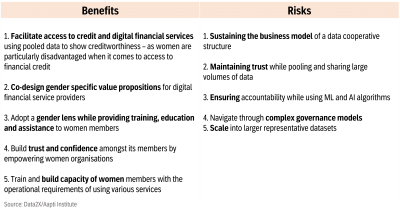
Use Case: Megha – a women farmer cooperative under the SEWA Federation (Shefali Girish, Aapti Institute)
The Aapti Institute works at the intersection of technology and society to build solutions that enhance societal impact, justice and equity. Their work spans many aspects of digital lives – they conduct research, develop solutions, and embed them in policy and within organisations to achieve scale.
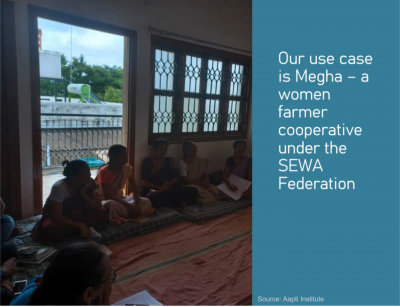
Megha Mandli is a women farmer cooperative located in Gujarat (India) with more than 1000 members. The cooperative has been initiated with the support of SEWA Federation, India’s first Women’s Federation. SEWA provides specialised services such as capacity building, training, access to markets and access to credit to the cooperative. Aapti Institute conducted a field visit to study the cooperative’s structure, its functions, how data is connected and the challenges the cooperative faces.
Exploring the value of adding a data layer to Megha
The women farmer cooperative currently mainly supports women farmers with business related planning and the acquisition of inputs such as paddy seeds or poultry feed. The Aapti institute believes that adding a data layer to the cooperative, i.e., pooling data from individual women farmers and their activities, would allow the women to release the social and economic value of data while they still control their own data.
The data layer has the power to redistribute the economic benefits of data and add value through several channels:
- The data layer can help pool data and demonstrate credit worthiness to digital financial service providers, allowing women to receive access to credit.
- It could empower female farmers through enhanced agency of its data. This means that women can control the data and use it to add more value to their outputs (e.g., use irrigation or fertilization data to improve agricultural output).
- Data cooperatives also mitigate the risk of AI because they can help curate and standardize representative datasets that could service training datasets which will reduce the potential for bias.
- Finally, data can also be pooled for farmers to share knowledge and learn about climate resilient practices and get data-driven advice to increase agricultural output.
The next step is to design a co-designing process to centre the experience of the members and transfer the decision-making power to them.
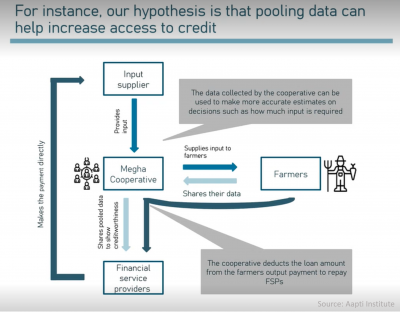
Catalysing data co-ops: a solutions roadmap
Data2X, the Aapti institute and some other partners are working on a roadmap on how to scale up gender data cooperatives in different locations in the world. The roadmap has three main steps:
SOLUTION 1: Ease the informational resources bottleneck by offering a practical, step-by-step guide on how to build a data cooperative. This includes a handbook on “How to Build a Data Cooperative” and interactive training materials for existing women’s co-ops and their support partners.
SOLUTION 2: Ease the collective action and financing bottlenecks by creating a gender data cooperative incubator. The first step is to locate women’s groups with interest and capacity to launch data co-ops. The incubator will then facilitate the co-design process, provide micro-grants, and offer personalized support services.
SOLUTION 3: Launch a “cooperative of cooperatives”: a Global Gender Data Cooperative to aggregate datasets for macro-scale policymaking. This entails thinking about a governance and representation structure for cooperative decision-making and the creation of a data fiduciary legal framework. The Global Cooprative will also create a safe data infrastructure for integrating intersectional data across platforms and ensure a secure universal identity to make the most vulnerable groups visible.